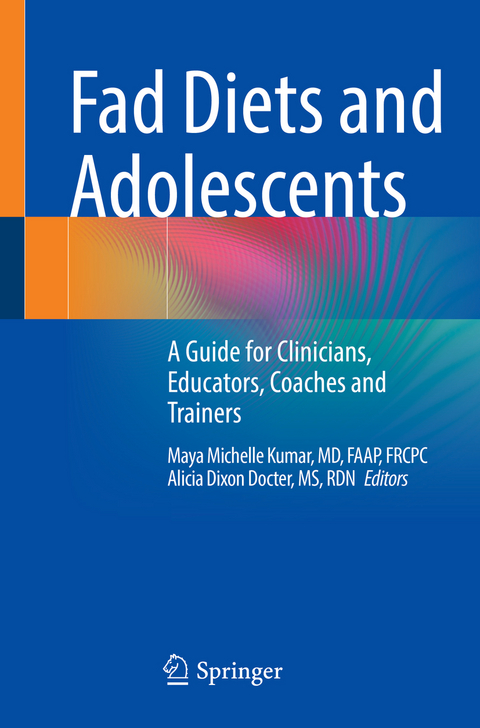
Fad Diets and Adolescents
Springer International Publishing (Verlag)
978-3-031-10564-7 (ISBN)
Fad diets have influenced our society for hundreds of years. While they are heterogeneous in nature, they make many of the same promises: weight loss, fat burning, muscle building, flatter stomachs, improved gut health, clearer skin, and protection of animal rights and the environment. Not only are fad diets usually ineffective, they are often highly restrictive and associated with significant health risks. Furthermore, the practice of fad dieting dramatically increases one's risk of developing malnutrition and/or an eating disorder.
Adolescence is a period of rapid physical and socioemotional growth during which young people become more vulnerable to poor body image and low self-esteem, which may make adolescents particularly likely to adopt fad diets. However, the nutritional risk incurred could result in serious and potentially permanent impairment of physical and psychosocial development.
This book provides an overview of fad diets through the ages, highlighting what all fad diets have in common and how to recognize a fad diet. Readers will learn what science tells us about nutritional needs during adolescence for normal physical, cognitive, and socioemotional development, and the risks that may be incurred if a fad diet prevents an adolescent from meeting these needs. This book examines why adolescents may be particularly prone to fad dieting and why they may also have more to lose if they adopt them. Readers will explore factors that shape adolescent diet culture. This book makes specific recommendations for caring adults in the lives of adolescents, including interdisciplinary health care providers, teachers, coaches, trainers, parents and other caregivers, to steer adolescents away from fad diets and towards healthier alternatives for achieving their goals.
The initial chapters are didactic chapters that outline core material. Subsequent chapters use illustrative case examples to teach the reader how to screen adolescents for fad dieting, listen to the concerns that attracted them to the diet, engage them in a discussion about their goals, and collaborate with them to find a healthier path. All chapters conclude with discussion questions for further reflection.
Maya Michelle Kumar, BMSc, MD, FAAP, FRCPC, is an Assistant Professor of Pediatrics in the Division of Adolescent and Young Adult Medicine at the University of California San Diego and Rady Children's Hospital San Diego. In her clinical practice, she provides inpatient care for children, adolescents, and young adults with severe medical complications of eating disorders, as well as outpatient care for youth with weight, eating, and feeding disorders. She is a sought-after teacher in the field of adolescent health, training psychology students, medical students, resident physicians, and general pediatricians in the care of adolescents with nutritional disorders. She has presented several workshops at internationally-attended conferences and has authored book chapters and clinical guidelines on the treatment and prevention of nutritional disorders in adolescents. She has been a member of the Society for Adolescent Health and Medicine Nutrition Committee since 2015, and was appointed as its Committee Chair in 2019. Alicia Dixon Docter, MS, RDN is core nutrition faculty and training director for the University of Washington (UW) Leadership Education in Adolescent Health (LEAH). In her recent role as ambulatory manager in Clinical Nutrition at Seattle Children's Hospital (SCH) and as an adolescent medicine-trained dietitian, she has trained numerous dietitians and health professionals in varied disciplines to work in inter-disciplinary settings with teenagers. She was instrumental in developing and managing the key pediatric weight management clinics at SCH (Child and Adolescent Wellness). SCH's approaches to addressing pediatric weight management have been recognized by NICHQ (National Initiative for Children's Healthcare Quality). Alicia is corresponding author for the CHA-sponsored Consensus Statement on the Role of the Registered Dietitian in a Stage 3 Weight Management Program. Her professional passions include inter-disciplinary teaming and training, ensuring excellent RD/clinician communication skills (including but not limited to compassionate care, culturally sensitive care, use of motivational interviewing (MI), avoidance of weight bias, addressing food insecurity and providing developmentally appropriate care). Her career focus has been to ensure the development of nutrition messaging that will promote normal eating and prevent disordered eating. She has been an invited speaker at the Academy of Nutrition and Dietetics (AND) and Society for Adolescent Health and Medicine (SAHM) and has authored/co-authored several book chapters on topics related to adolescent nutrition. Alicia is current past chair of the SAHM Nutrition and Obesity committee. During her tenure, this committee published two updated position papers on adolescent nutrition: Obesity in Adolescence (2016) and addressing nutrition disorders in adolescents (2018) and has another in press, Preventing Nutritional Disorders in Adolescents by Encouraging a Healthy Relationship with Food.
Part I : Content-Based Chapters.- 1. What Are Fad Diets?.- 2. A Brief History of Fad Diets and Diet Culture.- 3. Adolescent Diet Culture: Where Does It Originate?.- 4. An Overview of Food, Fluid, and Activity Recommendations for Adolescents.- 5. What Can We Do to Connect and Educate?.- 6. Fad Diets beyond the Western World.- 7. Healthy Alternatives to Fad Diets: The Total Diet Approach.- Part II : Case-Based Chapters.- 8. Muscle Mania: An Adolescent Male Athlete.- 9. An Athlete with Fatigue.- 10. Period Problems: An Adolescent with Amenorrhea.- 11. Like Mother, Like Son: An Adolescent Who Diets with his Parent.- 12. An Adolescent in the Performing Arts.- 13. Global Food Fads: An Adolescent from India.- 14. LGBTQ+ Adolescents, Disordered Eating, and Fad Diets.- 15. Fad Diets and Autism Spectrum Disorder.- 16. Cultural Considerations and Fad Dieting.- 17. An Adolescent with Chronic Abdominal Pain.- 18. An Adolescent with a Higher BMI.- 19. An Adolescent with Strong Beliefs.- 20. An Adolescent with Acne.- 21. Food Insecurity and Fad Dieting in Adolescents.- 22. An Adolescent with a Chronic Health Condition.
| Erscheinungsdatum | 17.11.2022 |
|---|---|
| Zusatzinfo | XI, 157 p. 2 illus., 1 illus. in color. |
| Verlagsort | Cham |
| Sprache | englisch |
| Maße | 155 x 235 mm |
| Gewicht | 333 g |
| Themenwelt | Geisteswissenschaften ► Psychologie ► Entwicklungspsychologie |
| Medizin / Pharmazie ► Gesundheitsfachberufe ► Diätassistenz / Ernährungsberatung | |
| Medizin / Pharmazie ► Medizinische Fachgebiete ► Pädiatrie | |
| Medizin / Pharmazie ► Medizinische Fachgebiete ► Psychiatrie / Psychotherapie | |
| Naturwissenschaften ► Biologie ► Biochemie | |
| Schlagworte | Fad Dieting • liquid diets • micronutrient fads • non-food substances • one evil food • one magic food |
| ISBN-10 | 3-031-10564-8 / 3031105648 |
| ISBN-13 | 978-3-031-10564-7 / 9783031105647 |
| Zustand | Neuware |
| Haben Sie eine Frage zum Produkt? |
aus dem Bereich


